ABSTRACT
Trace metals (Zn, Cu and Pb) fluxes were studied in five intertidal flats at Bodo Creek, Eastern Niger Delta, Nigeria in 2006, and re-evaluated in 2010 following two major oil spills that occurred in the creek. This study is the first to look at trace metal loads in the interstitial sediments of Bodo creek. Standard methods were employed in the sampling campaign and analysis. The concentration of all metals under study were higher than stipulated limit by WHO (2006) during post spill analysis. Concentration of Zn did not vary between stations and months pre-spill but did in post-spill, having values slightly higher than WHO (2006) stipulated limit. During the pre-spill sediment analysis, Pb concentrations ranged from no detection to 0.0012 mg/kg in 2006, increasing to 0.169 mg/kg post spill in 2010. Cu content ranged from 0.1312 - 0.1858 and 0.3374 - 0.4504 mg/kg pre- and post-spill, respectively. In addition to oil-induced metal loadings, the metals concentration dynamics show strong correlation with season. Metals had higher concentrations during the dry season due to reduced water volume in the creek and consequently less dilution. Implication for uptake, bioaccumulation and biotransformation by food species in the creek catchment above biosafety limits for user population is stressed and measures to avert public health consequences are advocated.
Key words: Trace metals, inter-tidal sediment, Niger Delta, oil pollution.
The Niger Delta is the hub of oil and gas production in Nigeria. It is also Africa’s largest wetland and the continent’s mangrove dominant region. Oil pollution substantially degrades the delta network of alluvial swamps and lands, creeks and rivers. Apparently, there is no consensus on the number of oil spills and volume of oil spilling into the delta environment, as the operating companies and government of Nigeria keep conflicting data (Amnesty International, 2009). However, a recent report by UNEP (2011) put the annual average number of oil spills and volume spilled into the delta environment at 273 and 115,000 barrels, respectively, making the delta one of the most oil spill vulnerable areas in the world (Steiner, 2008).
The exploration and exploitation of oil interfere with ecological and biodiversity integrity of ecosystems arising from flaring of associated gases, oil spills, use of drilling chemicals, etc. These processes can release trace metals into coastal waters. Pollution studies have revealed elevated levels of zinc (Zn), copper (Cu), lead (Pb), chromium (Cr), nikel (Ni), cadmium (Cd) and vanadium (V) in Niger Delta sediments and some species of fauna, suggesting inputs from petroleum exploration and exploitation (Kakulu and Osibanjo, 1992; Horsfall and Spiff, 2002; Howard et al., 2006). The direct impact of petroleum exploitation on the environment was illustrated in a study where trace metal levels of the Warri River were assessed before and after dredging a canal leading to an oil well (Ohimain et al., 2008). They noted that percentage increase was several folds for lead, zinc, copper, iron, chromium, manganese and cadmium. Trace metals are associated with crude oil in variable con-centrations depending on the geologic background of the oil (Onojake and Okonkwo, 2011). For Nigeria’s ‘sweet’ and dominant crude petroleum, Bonny Light, the associated metals occur in the order Ni>V>Cd>Cu>Pb (Osuji and Adesiyan, 2005). The concentration profile of trace metals (Zn, Cu and Pb) in soft-bottom sediments was assessed by the lead author as part of a 2-year (April 2006 to May 2008) baseline ecological survey of the ‘Dor Nwezor’ section of Bodo Creek. Information on other physico-chemistry, macrozoobenthos (tree, epifauna and infauna) of the study area (Dor Nwezor section of the creek) have been documented (Zabbey et al., 2010; Zabbey, 2012; Zabbey and Hart, 2011; Zabbey and Malaquias 2013). Shortly after the above study, 2 major crude oil spills hit Bodo creek from August 2008 to February 2009 from a Trans-Niger pipeline traversing the creek to Bonny export terminal (CEHRD, 2008; Amnesty International and CEHRD, 2011). Information on the spills and livelihood implication for the locals are reported by Pegg and Zabbey (2013). In this study, we compared the pre-spill and post spill concentrations of Zn, Cu and Pb in the intertidal flats to highlight changes in metal loads in time and space.
Study area
Occupying approximately 9,230 ha, Bodo Creek is a network of brackish water creeks flanking Bodo community on the upper reaches of the Andoni-Bonny estuarine system in Rivers State, Nigeria (Pegg and Zabbey, 2013). Four major channels conduct saline waters in and out of Bodo Creek: Dor Nwezor, Kpador, Koola Tobsoi and Koola Seato. These major waterways are intercon-nected by myriad of feeder channels, some of which terminate blindly in mangrove swamps (Onwugbuta-Enyi et al., 2008). This study was conducted at a protected mangrove swamp (Sivibilagbara) and four open and unvegetated low inter-tidal flats along the Dor Nwezor channel of Bodo Creek; approximately between latitude 04° 36’ 29.7’’N to 04° 35’ 26.3’’N and longitude 7° 15’ 30.2’’E to 7° 16’ 50.9’’E (Figure 1). Detailed information on some physico-chemical parameters in the creek had been documented (Onwugbuta-Enyi et al., 2008; Zabbey, 2012; Zabbey and Malaquias, 2013). Salinity of the creek interstitial water fluctuates between mesohaline (5 psu) and polyhaline (28 psu), while surface water values range from 6.2 - 22.7 psu. Surface and interstitial water temperature varied from 26.7 to 30.1 and 25 - 34°C, respectively.
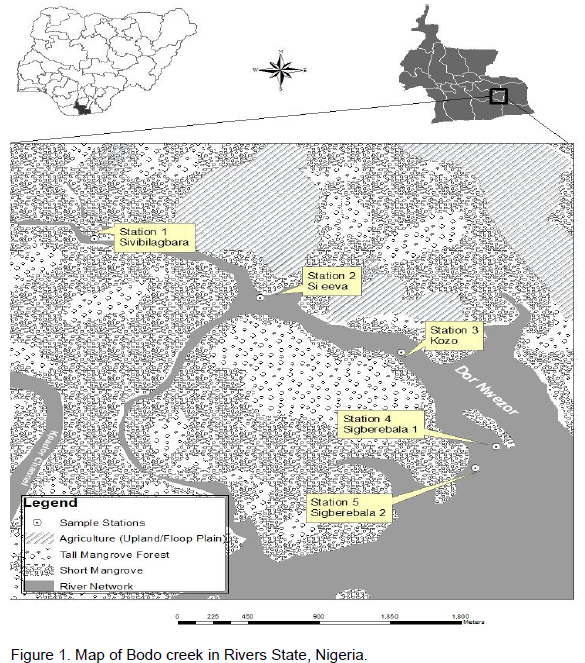
Sampling locations
Station 1
This was the most upstream station and was located in the Sivibilagbara protected mangrove swamp (approximately latitude 4° 36’ 29.7’’N and longitude 7° 15’ 30.2’’E (Figure 1). The vegetation of Sivibilagbara was homogenously red mangrove (Rhizophora racemosa) with knitted structural architecture of prop roots and thick intertwined crowns. The swamp dimension is approximately 105 x 42 m (4,410 m2). The sediment type was peaty clay (dominated by silt and clay) (Zabbey and Hart, 2014).
Station 2
This was located approximately 1,280 m downstream from station 1 (Figure 1) on an open, unvegetated tidal flat locally called Si Eeva. Facing downstream, the station lay to the left of Dor Nwezor main channel (latitude 4° 36’ 12.7’’ N and longitude 7° 16’ 08.1” E). The riparian vegetation of this station was mainly stunted red mangrove, and dwarf, aged and unproductive coconut trees at the edges of the supralittoral shores. The substratum was sandy mud.
Station 3
This was located approximately 956 m downstream from Station 2, on a right-flanked tidal platform. The station was sited opposite a sprawling fishing settlement called Kozo (lat. 4° 35’ 55.3’’ N and longitude 7° 16’ 33.8” E). The marginal vegetation was dominated by red mangrove (R. racemosa), with few stands of the white mangrove (Avicennia germinas) and mangrove sedge (Paspalum vaginatum) at the high intertidal zone. The date palm (Phoenix reclinata) and mango are amongst the mosaic admixture of plants at the supralittorial zone. The bottom was muddy sand.
Station 4
This was located 994 m downstream from station 3, having expansive unvegetated intertidal flat (latitude 4° 35’ 32.4” N and longitude 7°16’ 56.6” E). The sediment was sandy mud. Predominantly black mangrove and few stands of red mangrove and Nypa palm characterise the marginal vegetation.
Station 5
It is located on an expansive tidal mudflat (sandy mud) parallel to station 4. The marginal vegetation is dominantly black mangrove. The distance between stations 5 and 4 is approximately 256 and they are separated by the main creek channel. Station 5 was geo-located at latitude 4° 35’ 26.3” N and longitude 7° 16’ 50.9” E).
Field and laboratory procedures
Sediment samples were collected every month at low tide from intertidal flat locations along Dor Nwezor channels at Bodo Creek for 2 years (January – December 2006 and 2010), representing baseline and post spill respectively (Figure 1). Three replicate samples of the top 2 cm of sediment were collected with hand trowel and homogenised to form a composite sample per site during the sampling campaign. The sampling trowel was washed with the site water between replicates and with alcohol between stations (Chapman et al., 1996). The pooled sample of each location was covered in clean aluminium foil and transported in an ice-chest. In the laboratory, the sediment samples were analysed for Zn, Cu and Pb according to (APHA, 1995). Five grams of finely ground soil samples were weighed into 250 ml pyrex beakers and 10 ml of hydrogen peroxide (H2O2) added to it and allowed to warm for about 1 h during which most organic matter was destroyed. The content was transferred to savillex digestion bombs and concen-trated hydrochloric (HCl) acid and nitric acid (HNO3) were added in the ratio 5:10. The mixture was heated in a steam bath to a thick yellow liquid and the procedure repeated two times to get a clear solution indicating complete digestion of samples. Digested samples were cooled at room temperature, and filtered through a 0.45 μm membrane filter and diluted to 50 ml in volumetric flasks with double distilled water (Jin et al., 1999; Sastre et al., 2002). Following acid digestion, all samples were analyzed for the required metals (Zn, Pb and Cu) by flame atomic absorption spectrophotometer (Perkin Elmer Analyst AA 200 equipped with a high sensitivity nebulizer) calibrated by successive dilution of a 1000 mg/l multi - element instrument calibration standard solution.
All acid used were of analytical grade quality and control was assured by the use of procedural blanks and spikes. The spike recovery for each element was greater than 94%. All samples were run in triplicates and the relative standard deviation for the triplicate analysis was less than 10%. The instrument was calibrated with standard solutions prepared from Merck. The analytical blanks were run in the same way as the samples and concentrations were determined using standard solutions prepared in the same matrix. Doubled distilled water was used as solvent throughout the study. All glassware and other containers were thoroughly cleaned with 10% (w/v) nitric acid solution and finally rinsed with double distilled water several times and air dried prior to use. One-way analysis of variance (ANOVA) and Duncan’s test (p=0.05) were used in order to assess whether trace metal concentrations varied significantly between sites and months.
Sediment characteristics at Station 1 had particles in the sand fraction (very coarse to fine sand) constituted 13% of the sediment, while clay represented 82.7%. The silt and clay proportions at Stations 2-5 ranged from 14.3 to 49.2%. Gravelly particles constituted 4 and 0.7% of sediments at Stations 1 and 5, respectively, whereas this class fraction was apparently lacking at Stations 2–4. The sand fraction ranged from 13.3% at Station 1 to 85.7% at Station 3. Particle size variation may influence trace metal loads at different stations studied. Silt and clay may retain and lock away metals preventing re-suspension while sand particles may readily release metals into solution during re-suspension. Generally, the levels of metal load in the present study may not be conclusive as low levels may simply mean more metal is locked away in silt and clay and not available during this survey. However, such contaminants may be re-suspended during dredging activities which are frequent at the study area.
The highest and lowest concentration values of Zn were recorded in the months of July and May (0.237 and 0.205 mg/kg, respectively) (Figure 2). The 2006 zinc monthly concentrations were not statistically different (P = 0.105; P >0.05). There was also no statistical variation in the concentration of Zn at all stations between the weighted averages of the wet and dry seasons in 2006 (P = 0.113) (Figure 5). Zinc concentrations were higher in 2010 than 2006 at all stations and in all the months at statistically significant levels (P = 0.0244) (Figure 5). This variation may have been due to the oil spill incidents in Bodo creek in 2008 and 2009 (Pegg and Zabbey, 2013). Concentration of Zn at all stations in both years was also higher than stipulated limit (0.01 mg/kg) by WHO (2006). In 2010, Zn concentration values were highest and lowest in the months of January and October, respectively. Significant variation in contents were recorded between the wet and dry seasons in 2010 (P = 0.0227), with dry season values being higher at all stations (Figure 5). Seasonal variation may be attributed to less dilution of Zn in dry season leading to higher concentration and spatial variation may be due to varying impact from incidental inwelling sources at various stations. Lead concentrations did not vary significantly across the wet season months in 2006 (P = 0.222) ranging from below detection limit in August, September and October to 0.0012 mg/kg in May (Figure 3). During the wet season months in 2006, Pb was only detected at stations 2 and 3 in May, station 5 in June and stations 2, 3 and 4 in July. During the dry season months (November – April, 2006), Pd was detected only in November, March and April at all stations with the highest and lowest levels in March and April (0.0016 and 0.001 mg/kg), respectively. The concentration varied only numerically across the three months (P = 0.104; P > 0.05). Lead concentrations also did not vary significantly between the wet and dry seasons at all stations (P = 1.00). This result is similar to that reported for Pb (Onojake and Okonkwo, 2011) in surface and sub-surface soils in Bodo near the creek and lower than the limit of 0.01 mg/kg stipulated by WHO (2006). In 2010 however, Pb was detected at all stations and in all the months. Its concentration ranged between 0.074 mg/kg in October to 0.1206 mg/kg in July (wet season) and 0.066 to 0.169 mg/kg in March (dry season).
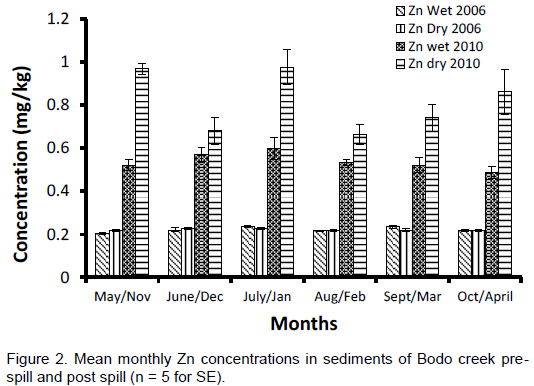

The highest Pb concentration was recorded at station 2 in wet season and station 1 in dry season in 2010 (Figure 6). Lead values varied significantly between wet and dry seasons in 2010 (P = 0.003). Lead values in 2010 were higher than those recorded in 2006 and higher than those reported by Onojake and Okonkwo (2011) and stipulated limit of 0.01 mg/kg by WHO (2006). This variation may have been due to the oil spill incidents in 2008 and 2009 (Pegg and Zabbey, 2013).
The concentration of Cu in all the stations investigated in 2006 ranged between 0.1312 and 0.1858 mg/kg with no statistical variation between the months (Figure 4). The highest and lowest values were recorded in March and May, respectively. There was no statistical variation in the concentration of Cu between the wet and dry seasons in 2006 (P =0.052). However, dry season recorded the highest value of Cu at station 2 while the
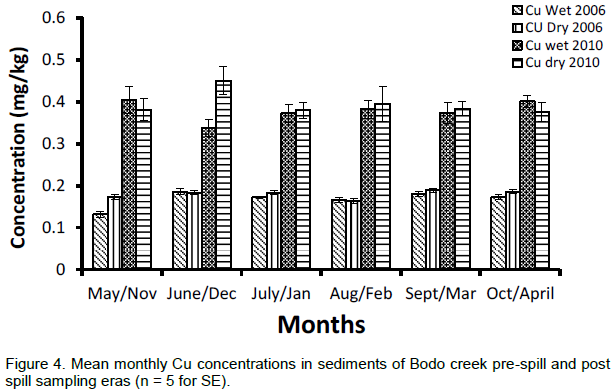
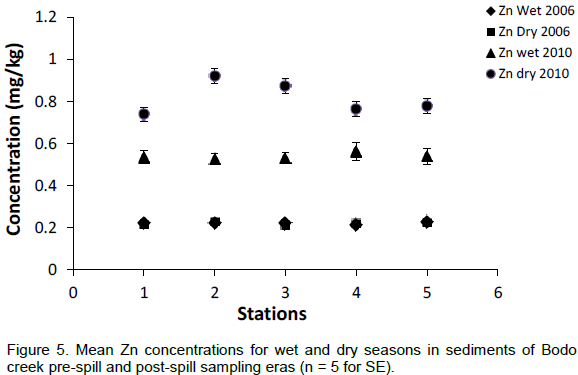
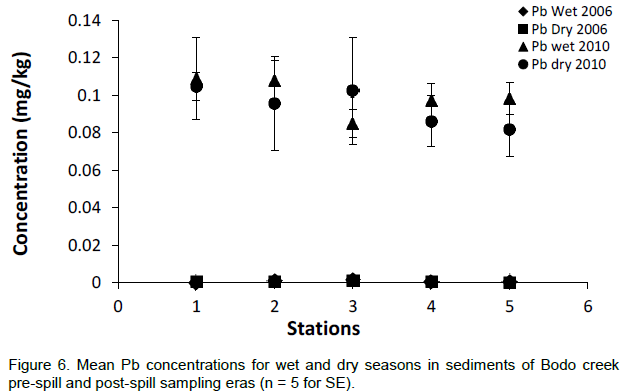
lowest value was recorded in wet season at station 3. In 2010, however, Cu concentrations ranged from 0.3374 mg/kg in June to 0.4504 mg/kg in December. Its concentration varied statistically between the wet and dry seasons (P = 0.001). The highest and lowest values were recorded at stations 5 and 1 in dry season and stations 3 and 2 in wet season, respectively; overall, dry season had higher values. Elevated concentration of metals in the dry season may be attributable to evaporation which leaves behind less water and thus more concentrated solution-dilution in the wet season was as a result of increased volume of exogenous water. Cu values in 2010 were higher than those in 2006 at all stations in all the months (Figure 7), increment was possibly due to the oil spill contamination. However, Cu values were below stipulated limit of 2 mg/kg by WHO (2006).
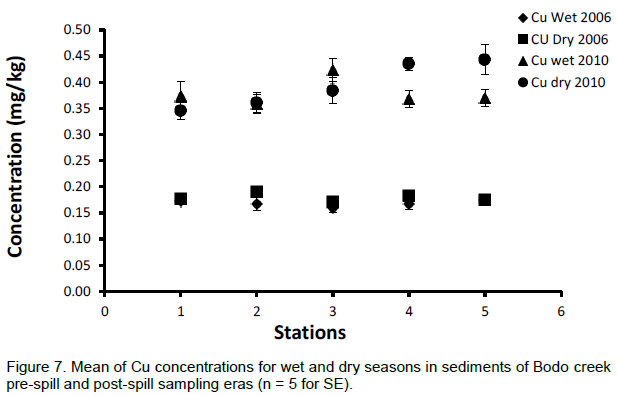
Seasonal variations in the concentrations of the metals investigated may be due to the effect of dilution during the rains and evaporation during the dry season and this agrees with the report of Chindah et al. (2004). Spatial variation in trace metal load was not statistically signifi-cant (P>0.05), suggesting that common and anthropoge-nic sources contributed to the metal loading especially from the oil spills in Bodo creek in 2008 and 2009 (Pegg and Zabbey, 2013). Results of trace metals under study compares well with other reports on sediments in creeks and rivers in the Niger Delta that have been impacted by oil (Horsefall and Spiff, 2002; Obire et al., 2003; Chindah et al., 2004; Hart et al., 2005; Davies et al., 2006; Ubalua et al., 2007; Gideon and Chidiebere, 2008). However, some of the studies reported higher trace metal loads in similar oil contaminated environment in the Niger Delta, even much higher in organisms analysed for the same environment suggesting bioaccumulation of these metals (Chindah et al., 2004). In a similarly polluted river system in the Niger Delta, Horsefall and Spiff (2002) reported trace metal load in sediment and biota of the New Calabar river to be higher than those in the present study.
Results of trace metals compared between 2006 (pre-spill) and 2010 (post-spill) showed clearly that metal loads increased significantly after the oil spills in Bodo creek in 2008 and 2009. The present result shows that there are possibilities of high human exposure to trace metals in study area given that inhabitants of the study area consume biota from the studied creek. Further studies on trace metals in biota, particularly food species, and assessment of bioaccumulation factors are impera-tive to determine human exposure to trace metal loads detected in the present study following major oil spills. Some aquatic organisms have been reported to have capacity to concentrate trace metals such as Fe, Cu, Zn up to 105 times the concentration present in the water, making potential human health hazards associated with the consumption of contaminated sea food 20 to 40 times higher than the ingestion of contaminated water (WHO, 2011). Health effects of these trace metals (Pb, Zn and Cu) in humans have been demonstrated in acute toxicity, neurotoxicity and nephrotoxicity (Katz and Salem, 1993; ATSDR, 2000; Stift et al., 2000). Pb in particular is a confirmed carcinogen (Martin and Griswold, 2009; WHO, 2011).
The authors did not declare any conflict of interest.
REFERENCES
|
American Public Health Association (APHA) (1995). Standard methods for the examination of water and wastewater 19th Ed.
|
|
|
|
Amnesty International & Centre for Environment, Human Rights and Development (CEHRD) (2011). The true tragedy; delays and failures in tackling oil spills in the Niger Delta. Amnesty International Secretariat, London.
|
|
|
|
|
Amnesty International (2009). Nigeria: Petroleum, Pollution and Poverty in the Niger Delta. Amnesty International Secretariat, London.
|
|
|
|
|
ATSDR (2000) Toxicological profile for chromium. Atlanta, Georgia, United States Department of Health and Human Services, Public Health Service, Agency for Toxic Substances and Disease Registry.
|
|
|
|
|
Centre for Environment, Human Rights and Development (CEHRD) (2008). Persistent oil spillage at Bodo Creek; unprecedented impacts on ecosystem stability, biodiversity and food security of Ogoni communities. www.cehrd.org
|
|
|
|
|
Chapman PM, Paine MD, Arthur AD, Taylor LA (1996). A triad study of sediment quality associated with a major, relatively untreated marine sewage discharge. Mar. Pollut. Bull. 31:47-64.
Crossref
|
|
|
|
|
Chindah AC, Braide AS, Sibeudu OC (2004) Distribution of hydrocarbons and tracemetals in sediment and a crustacean (Penaeus notialis) from the Bonny River/New Calabar River Estuary, Niger Delta. Afr. J. Environ. Assess. Manag. 9:1-17.
|
|
|
|
|
Davies OA, Allison ME, Uyi HS (2006). Bioaccumulation of tracemetals in water, sediment and periwinkle (Tympanotonus fuscatus var radula) from the Elechi Creek, Niger Delta. Afr. J. Biotechnol. 5:968-973.
|
|
|
|
|
Gideon OA,Chidiebere GE (2008). The current pollution status of the new Calabar River in the Niger Delta region of Southern Nigeria: A survey of antibiogram profiles of its bacterial isolates. Afr. J. Environ. Sci. Technol. 2:134-141
|
|
|
|
|
Hart AD, Oboh CA, Barimalaa IS, Sokari TG (2005), Concentrations Of Trace Metals (Lead, Iron, Copper And Zinc) In Crops Harvested In Some Oil Prospecting Locations In Rivers State, Nigeria. Afr. J. Food Agric. Nutr. Dev. 5:1-21
|
|
|
|
|
Horsfall M, Spiff AI (2002) Distribution and partitioning of trace metals in sediments of the lower reaches of the New Calabar River, Port Harcourt, Nigeria. Environ. Manage. Assess. 78:309-326.
Crossref
|
|
|
|
|
Howard IC, Horsfall M, Spiff IA, Teme SC (2006). Trace metals levels in surface waters and sediments in an oilfield in the Niger Delta, Nigeria. Glob. J. Pure Appl. Sci. 12: 79-83
|
|
|
|
|
Jin Q, Liang F, Zhang H, Zhao L, Huan Y, Song D (1999). Application of microwave techniques in analytical chemistry, Pract. Trends Anal. Chem. 18(7):479-484.
Crossref
|
|
|
|
|
Kakulu SE, Osibanjo O (1992). Pollution studies of Nigerian rivers: trace metal levels of surface water in the Niger Delta area. Int. J. Environ. Stud. 41:287-293.
Crossref
|
|
|
|
|
Katz SA, Salem H (1993). The toxicology of chromium with respect to its chemical speciation: A review. J. Appl. Toxicol. 13:217-224.
Crossref
|
|
|
|
|
Martin S, Griswold W (2009). Human Health Effects of Trace Metals. Center for Hazardous Substance Research (CHSR).
|
|
|
|
|
Obire O, Tamuno DC, Wemedo SA (2003). Physicochemical quality of Elechi Creek in Port Harcourt, Nigeria. J. Appl. Sci. Environ. Manage 7:43-49.
|
|
|
|
|
Ohimain EI, Gbolagade J, Abah SO (2008). Variations in TraceMetal Concentrations Following the Dredging of an Oil Well Access Canal in the Niger Delta. Adv. Biol. Res. 2:97-103
|
|
|
|
|
Onojake MC, Okonkwo V (2011). Trace Metals Associated with Oil Spillage: A case study. J. Chem. Pharm. Res. 3(6):742-751.
|
|
|
|
|
Onwugbuta-Enyi J., Zabbey N, Erondu ES, (2008). Water quality of Bodo creek in the lower Niger Delta Basin. Adv. Environ. Biol. 2:132-136.
|
|
|
|
|
Osuji LC, Adesiyan SO (2005). Extractable hydrocarbons, nickel and vanadium contents of Ogbodo-Isiokpo oil spill polluted soils in the Niger Delta, Nigeria. Environ. Mon. Assess. 110: 129 – 130.
Crossref
|
|
|
|
|
Pegg S., Zabbey N (2013). Oil and water: the Bodo spills and the destruction of traditional livelihood structures in the Niger Delta. Commun. Dev. J. 48:391-405.
Crossref
|
|
|
|
|
Sastre J, Sahuquillo A., Vida, M, Rauret G (2002). Determination of Cd, Cu, Pb and Zn in environmental samples: microwave-assisted total digestion versus aqua regia and nitric acid extraction. Anal. Chim. Acta 462:59-72.
Crossref
|
|
|
|
|
Steiner R (2008) Double standards? International standards to prevent and control pipeline oil spills, compared with shell practices in Nigeria. A report submitted to Friends of the Earth, The Netherlands.
|
|
|
|
|
Stift A., Friedl J., Langle F, Berlakovich G, Steininger R, Muhlbacher F (2000). Successful treatment of a patient suffering from severe acute potassium dichromate poisoning with liver transplantation. Transplantation 69:2454-2455
Crossref
|
|
|
|
|
Ubalua AO, Chijioke UC Ezeronye OU (2007). Determination and assessment of tracemetal content in fish and shellfish in Aba River, Abia state, Nigeria. KMITL Sci. Technol. J. 7(1):31-45
|
|
|
|
|
UNEP (United Nations Environment Programme). 2011.Environmental assessment of Ogoniland. Nairobi: UNEP.
|
|
|
|
|
WHO (2011). Adverse health effects of traceMetals in children. Children's Health and the Environment WHO Training Package for the Health Sector World Health Organization www.who.int/ceh
|
|
|
|
|
WHO (2006). Guidelines for drinking-water quality. Incorporating first addendum. Vol. 1, Recommendations. 3rd ed.
|
|
|
|
|
Zabbey N, Hart AI (2011). Preliminary checklist of macrozoobenthos of Bodo Creek in the Niger Delta, Nigeria. Niger. J. Fish. 8 (2):271-283.
|
|
|
|
|
Zabbey N, AI Hart (2014). Spatial variability of macrozoobenthic diversity on tidal flats of the Niger Delta, Nigeria: the role of substratum. Afr. J. Aquat. Sci. 39(1):67-76.
Crossref
|
|
|
|
|
Zabbey N, Hart AI, Wolff WJ (2010). Population structure, biomass and production of the West African lucinid Keletistes rhizoecus (Bivalvia, Mollusca) in Sivibilagbara swamp at Bodo Creek, Niger Delta, Nigeria. Hydrobiologia 654:193-203.
Crossref
|
|
|
|
|
Zabbey N, Malaquias MA (2013). Epifauna diversity and ecology on intertidal flats in the tropical Niger Delta, with remarks on the gastropod species Haminoea orbignyana. J. Mar. Biol. Assoc. UK. 93:249-257.
Crossref
|
|
|
|
|
Zabbey N (2012). Spatial and temporal variability in interstitial water quality of soft-bottom flats at Bodo Creek, Eastern lower Niger Delta, Nigeria. Trop. Freshw. Biol. 21(1):83-103 83
|
|